
Place the numbers 1 through 12 in the circles so that the distance between successive pairs (measured between centers of corresponding circles) is increasing. For example, the distance between 1 and 2 must be less than the distance between 2 and 3, which must be less than the distance between 3 and 4, etc.
1. Distance

2. Balancing Act
Assign the numbers 1 through 12 to the weights in the diagram so that everything balances as shown. At each fulcrum, the total torque on both sides of the balance must be the same. Each value will be used exactly once.

3. Rolling Cube Maze
Roll the dark cube from Start (S) to Finish (F) without the orange face ever facing down. The dark cube must stay within the boundaries of the 7x7 grid. The 10 light cubes are barriers that do not move.

4. Another Rolling Cube Maze
Each of the red blocks can roll, but never change levels. The gray walls are barriers which do not move. A block cannot roll if it is obstructed by other blocks or barriers, if it would fall outside the edge of the maze, or if it would not be fully supported from below. The goal is to get the top block to the Finish (F).

5.-14. Battleships Variations
In the following puzzles, you are to place the ships so that the total number of ship segments in each row and column are given. Ships cannot be adjacent, even diagonally. The ships placed must be one 4x1 battleships, two 3x1 crusiers, three 2x1 destroyers, and four 1x1 submarines.
5. Non-rounded Battleships
In this puzzle, ends of ships are not rounded as they usually are.

6. Squared Battleships
In this puzzle, the ships are 1x1, 2x2, 3x3, and 4x4 squares.

7. Minesweeper Battleships
In this puzzle, the numbers in a square indicate the number of ship segments in the horizontally, vertically, and diagonally adjacent squares.
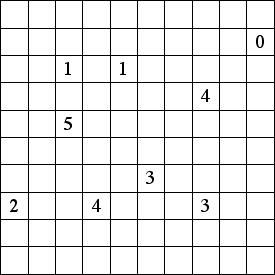
8. Ship Battleships
In this puzzle, the numbers indicate the number of different ships in that row or column, not the number of ship segments.

9. Easy as Battleships
In this puzzle, the numbers are the length of the first ship visible from that row or column.
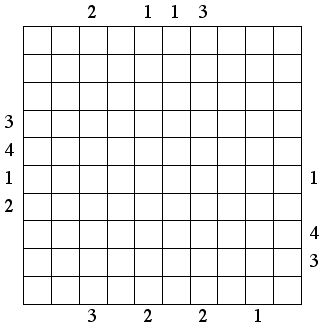
10. Crowded Battleships
In this puzzle, the frequenncy of ships is reversed. There is one submarine, two destroyers, three cruisers, and four battleships.
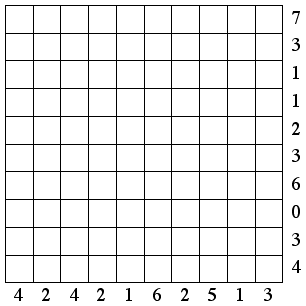
11. Retrograde Battleships
In this puzzle, choose the ships from the ones given.
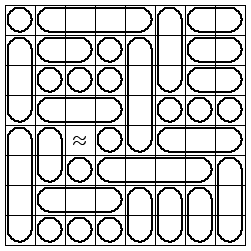
12. Either/Or Battleships
In this puzzle, the number of ship segments in each row or column is one of the two numbers provided.

13. Diagonal Battleships
In this puzzle, the ships are located diagonally instead of horizontally and vertically.
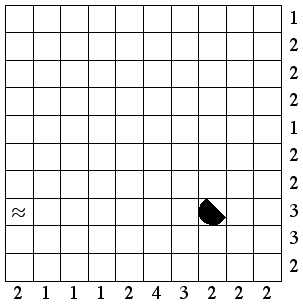
14. Hexagonal Battleships
In this puzzle, the ships are located in a hexagonal grid.
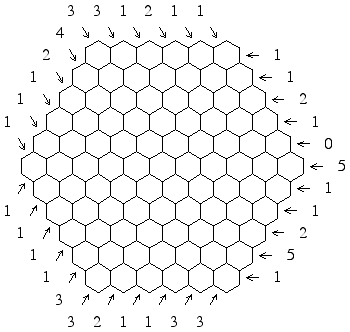
15. Numerical Jigsaw
Rearrange the six vertical strips so that each row contains a true equation. Strips can be permuted and rotated.
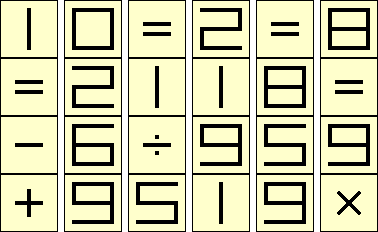
16. Do or Die
Place the six die faces, with one through six pips, into the grid. A face covers a 3x3 region of the grid, and faces are not allowed to overlap. The numbers outside the grid indicate how many pips are in that row or column. The face with six pips may be oreiented either horizontally or vertically.

17. Equations
Enter a different digit from 1 to 9 into each of the boxes so that each of the four equations reading across is true.

18. Hexasperation
Find a looped path through the grid so that the path 1) proceeds from each cell to adjacent cell, 2) goes through each cell no more than once, 3) does not go through any numbered cells, and 4) never makes a sharp 60o turn. The numbers in the grid indicates how many of the adjacent cells are part of the path.
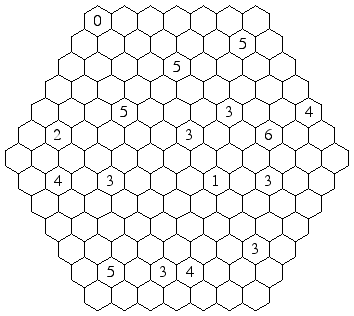
Click here for the answers.